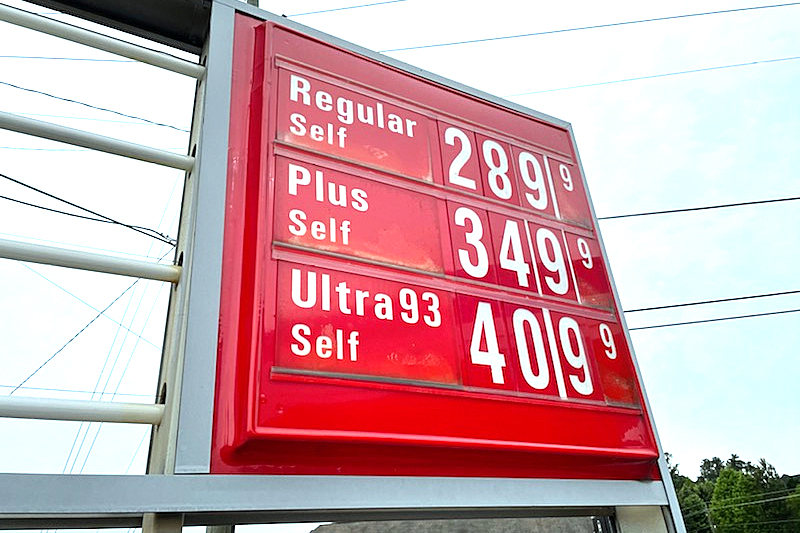Everywhere you turn, prices seem to be increasing significantly on just about everything: airfares, lodging, fuel, rental cars, food, and a plethora of other items — and one reason is due to all of the shortages of supplies, shipping containers, and labor, which have led to shortages of such items as ketchup, lumber, chicken wings, rubber, and even coins.
Does Everything Seem More Expensive in 2021? That’s Likely Because Airfare, Lodging, Fuel, Rental Cars, and Other Items Are More Expensive

Although certain problematic supply and demand issues had been ongoing, many of the issues were either caused — or further exacerbated — by the current 2019 Novel Coronavirus pandemic, which shut down virtually the entire planet for approximately 16 months. For example, a shortage of semiconductor chips for new automobiles has been chiefly responsible for the astronomic increase in rental car rates worldwide — especially in Hawaii, Alaska, and other popular vacation destinations as people scramble to travel after being locked down, isolated, or quarantined for greater than a year — but this issue was already occurring prior to the pandemic.
Prices for many products and services did decrease significantly as a result of the pandemic. The cost of a gallon of gasoline was reduced to prices which had not been seen in decades in some areas of the United States; but increased demand recently due to more people traveling, a shortage of truck drivers, and higher oil prices caused the price of a gallon of gasoline to reach the highest levels in recent years…
…and when prices dip so precipitously, their quick recovery may seem rather harsh — as evidenced by the Consumer Price Index for June of 2021 from the Bureau of Labor Statistics of the United States: “The Consumer Price Index for All Urban Consumers (CPI-U) increased 0.9 percent in June on a seasonally adjusted basis after rising 0.6 percent in May, the U.S. Bureau of Labor Statistics reported today. This was the largest 1-month change since June 2008 when the index rose 1.0 percent. Over the last 12 months, the all items index increased 5.4 percent before seasonal adjustment; this was the largest 12-month increase since a 5.4-percent increase for the period ending August 2008.”
The following chart from the Bureau of Labor Statistics shows that the most significant unadjusted increases over the past twelve months occurred with used cars and trucks — followed by gasoline and fuel oil, and then transportation services.
Percent changes in Consumer Price Index for All Urban Consumers: United States City Average
All items — with the exception of those with a dark red asterisk or * — are seasonally adjusted changes from the preceding month.
| December 2020 |
January 2021 |
February 2021 | March 2021 | April 2021 | May 2021 | June 2021 | Unadjusted 12 months ended June 2021 |
|
|---|---|---|---|---|---|---|---|---|
| All Items | 0.2 | 0.3 | 0.4 | 0.6 | 0.8 | 0.6 | 0.9 | 5.4 |
| Food | 0.3 | 0.1 | 0.2 | 0.1 | 0.4 | 0.4 | 0.8 | 2.4 |
| Food at Home | 0.3 | -0.1 | 0.3 | 0.1 | 0.4 | 0.4 | 0.8 | 0.9 |
| Food Away From Home* | 0.4 | 0.3 | 0.1 | 0.1 | 0.3 | 0.6 | 0.7 | 4.2 |
| Energy | 2.6 | 3.5 | 3.9 | 5.0 | -0.1 | 0.0 | 1.5 | 24.5 |
| Energy Commodities | 5.1 | 7.3 | 6.6 | 8.9 | -1.4 | -0.6 | 2.6 | 44.2 |
| Gasoline — All Types | 5.2 | 7.4 | 6.4 | 9.1 | -1.4 | -0.7 | 2.5 | 45.1 |
| Fuel Oil* | 10.2 | 5.4 | 9.9 | 3.2 | -3.2 | 2.1 | 2.9 | 44.5 |
| Energy Services | 0.2 | -0.3 | 0.9 | 0.6 | 1.5 | 0.7 | 0.2 | 6.3 |
| Electricity | 0.4 | -0.2 | 0.7 | 0.0 | 1.2 | 0.3 | -0.3 | 3.8 |
| Utility (Piped) Gas Service | -0.4 | -0.4 | 1.6 | 2.5 | 2.4 | 1.7 | 1.7 | 15.6 |
| All Items Less Food and Energy | 0.0 | 0.0 | 0.1 | 0.3 | 0.9 | 0.7 | 0.9 | 4.5 |
| Commodities Less Food and Energy Commodities | 0.1 | 0.1 | -0.2 | 0.1 | 2.0 | 1.8 | 2.2 | 8.7 |
| New Vehicles | 0.4 | -0.5 | 0.0 | 0.0 | 0.5 | 1.6 | 2.0 | 5.3 |
| Used Cards and Trucks | -0.9 | -0.9 | -0.9 | 0.5 | 10.0 | 7.3 | 10.5 | 45.2 |
| Apparel | 0.9 | 2.2 | -0.7 | -0.3 | 0.3 | 1.2 | 0.7 | 4.9 |
| Medical Care Commodities* | -0.2 | -0.1 | -0.7 | 0.1 | 0.6 | 0.0 | -0.4 | -2.2 |
| Services Less Energy Services | 0.0 | 0.0 | 0.2 | 0.4 | 0.5 | 0.4 | 0.4 | 3.1 |
| Shelter | 0.1 | 0.1 | 0.2 | 0.3 | 0.4 | 0.3 | 0.5 | 2.6 |
| Transportation Services | -0.6 | -0.3 | -0.1 | 1.8 | 2.9 | 1.5 | 1.5 | 10.4 |
| Medical Care Services | -0.1 | 0.5 | 0.5 | 0.1 | 0.0 | -0.1 | 0.0 | 1.0 |
Meanwhile, the Council of Economic Advisers — which is an agency within the executive office of the president of the United States — released a series of messages at its official Twitter account that discuss the increases in prices; and airline fares is used specifically as an example.
Part of this was due to base effects, reflecting the depressed prices from last spring. Controlling for base effects by smoothing across the 14 months since February 2020, the rate of core CPI inflation was 2.2%. 2/ pic.twitter.com/T4tAGXDZsK
— Council of Economic Advisers (@WhiteHouseCEA) May 12, 2021
According to this message, “…airline fares rose by 10.2% month-over-month, but prices in that sector remain well below their pre-pandemic level.”
Separately, part of the increase was due to a “normalization” in prices in some sectors that had been hard hit by the pandemic, as their prices continue to climb out of their pandemic low level. 4/
— Council of Economic Advisers (@WhiteHouseCEA) May 12, 2021
“A price index of pandemic-affected services shows a sharp increase in April, but that the level of prices is still below the pre-pandemic level”, according to this message.
A price index of pandemic-affected services shows a sharp increase in April, but that the level of prices is still below the pre-pandemic level 6/ pic.twitter.com/rWN6Viy7PO
— Council of Economic Advisers (@WhiteHouseCEA) May 12, 2021
According to the last of the series of messages, “As the economy recovers, there will be months that come in below or above expectations as strong demand meets recovering supply. Recovery from the pandemic will not be linear. The Council of Economic Advisers will continue to monitor the data as they come in.”
Summary
Relief may be in sight in some industries — the price of lumber is reportedly waning from its recent peak — but I do not believe that the rates of rental cars will subside as long as shortages of such components as semiconductors and rubber are prevalent in the supply chain. Stricter discipline in the pricing of renting vehicles may also eventually occur even when supplies return to normal, which may potentially be unfavorable to consumers in the form of higher rental rates — especially when rental car companies have realized how much they can charge customers per day when demand is high and supply is low.
Although not at the low prices seen within the past year, airfares are still reasonably priced to many destinations — and they are still quite low to Alaska and other certain places where rental cars are almost impossible to procure. Just be sure that you are paying a reasonable airfare and not being gouged by mandatory fees, as one airline tried to charge a recovery fee for the current 2019 Novel Coronavirus pandemic and still charges a High Cost Airport Charge to certain destinations.
The lodging industry is experiencing fewer vacancies and is thus able to charge higher room rates — as well as tack on new fees and increase existing fees. For example, some hotel and resort properties have started adding a mandatory energy surcharge to folios when guests check out — although one hotel property has reportedly since rescinded that policy and removed the surcharge.
Food continues to sporadically be a challenge — whether the supply is depleted at a supermarket or a restaurant cannot hire enough staff to offer full service. Many fast food restaurants close their dining rooms earlier, as customers can only order food through the drive-thru window — if it is not closed earlier than the posted hours.
The bottom line is as it always has been: caveat emptor — let the buyer beware — and keep trying to find ways to get the most out of your money…
All photographs ©2019 and ©2021 by Brian Cohen.

